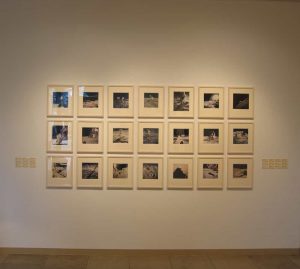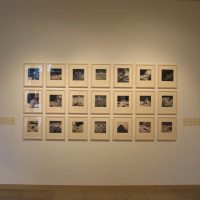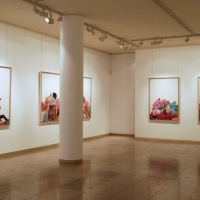Category: Munich
February 22, 2012 – March 3, 2012
A special preview at our Munich gallery of our exhibition in New York opening at C.G. Boerner on March 27th.
As Picasso was the central star for painting and Man Ray for modern photography, Gustave Le Gray was the prominent figure early 19th Century photographers had to conquer before they could make a name for themselves.
Like many of his colleagues, Le Gray was a painter before he enthusiastically embraced the new medium of photography. By 1849 he had entered the Paris photo scene with his calotype landscapes taken in Fontainebleau and from there found further influence teaching photography to a group of students including Du Camp, Le Secq, Mestral and Tournachon, who in turn would also go on to achieve great fame in photography.
His ground breaking inventions rapidly set new standards for size and quality. In 1857, his Vague Brisée, a “snap-shot” of a small boat with wind-filled sails and a breaking wave in the foreground, was shown to an approving and fascinated audience.
As a technical perfectionist, Le Gray was above all a great painter with the camera.
In addition to the excellent Vague Brisée three new discoveries will be shown, calotypes taken at Fontainebleau castle. Rare treasures from the estate of his colleague Le Secq, they appear to be the only surviving examples of these images.
We are thrilled to present these works to our American audience and consider our gallery very fortunate to reintroduce these pictures to the œuvre of Le Gray.
Please click here for information about our New York exhibition
December 13, 2011 – January 31, 2012
Daniel Blau is pleased to present a unique collection of rare vintage NASA photographs. These incredible pictures depict the wonder and awe of space travel.
These photographs have become part of our collective visual memory for the twentieth century; pictures that markedly symbolise the speed and power of post-war technological development at a time when Cold War tension was rife between the US and Russia. And so began the space race; the period of the 1960’s that saw the first man on the Moon. Missile technology, taken from Germany at the close of WWII, set the technological precedence for manned space crafts to orbit the Earth, eventually landing on lunar soil: a period in human history incomparable to any other; photographed, with immense beauty, for the whole world to gaze in astound.
These are not simple snap-shots by an amateur, taken with a Kodak box, but the result of the combined efforts of thousands of workers and scientists at NASA. Indeed, these are the most expensive photographs ever produced. To see these prints in the flesh is an experience as close to bouncing on lunar soil as any of us will ever get. These magnificent landscapes can be compared to Gustav Le Gray’s large prints of Fontainebleau or his seascapes. Today we treasure these vintage prints for their artistic quality and as permanent visual evidence of a time when the future seemed so close…
‘…Our first shock comes as we stop our spinning motion and swing ourselves around so as to bring the Moon into view. We have not been able to see the Moon for nearly a day now, and the change is electrifying. The Moon I have known all my life, that two-dimensional small yellow disk in the sky, has gone away somewhere, to be replaced by the most awesome sphere I have ever seen. To begin with, it is huge, completely filling our window. Second, it is three-dimensional. The belly of it bulges out toward us in such a pronounced fashion that I almost feel I can reach to touch it…’
– Michael Collins, Apollo XI, July 1969 (NASA Sp-350, 1975, p. 207)
December 13, 2011 — January 31, 2012
Daniel Blau is pleased to present a unique collection of rare vintage NASA photographs. These incredible pictures depict the wonder and awe of space travel.
These photographs have become part of our collective visual memory for the twentieth century; pictures that markedly symbolise the speed and power of post-war technological development at a time when Cold War tension was rife between the US and Russia. And so began the space race; the period of the 1960’s that saw the first man on the Moon. Missile technology, taken from Germany at the close of WWII, set the technological precedence for manned space crafts to orbit the Earth, eventually landing on lunar soil: a period in human history incomparable to any other; photographed, with immense beauty, for the whole world to gaze in astound.
These are not simple snap-shots by an amateur, taken with a Kodak box, but the result of the combined efforts of thousands of workers and scientists at NASA. Indeed, these are the most expensive photographs ever produced. To see these prints in the flesh is an experience as close to bouncing on lunar soil as any of us will ever get. These magnificent landscapes can be compared to Gustav Le Gray’s large prints of Fontainebleau or his seascapes. Today we treasure these vintage prints for their artistic quality and as permanent visual evidence of a time when the future seemed so close…
‘…Our first shock comes as we stop our spinning motion and swing ourselves around so as to bring the Moon into view. We have not been able to see the Moon for nearly a day now, and the change is electrifying. The Moon I have known all my life, that two-dimensional small yellow disk in the sky, has gone away somewhere, to be replaced by the most awesome sphere I have ever seen. To begin with, it is huge, completely filling our window. Second, it is three-dimensional. The belly of it bulges out toward us in such a pronounced fashion that I almost feel I can reach to touch it…’
– Michael Collins, Apollo XI, July 1969 (NASA Sp-350, 1975, p. 207)

October 21, 2011 – December 23, 2011
During the Kunstwochenende (Munich Art Weekend) Daniel Blau will be showing the works of British artist Rachel Kneebone. In her first solo show in Germany, Kneebone will exhibit a group of finely detailed porcelain sculptures. These objects grapple with themes of sexuality and death, drawing the viewer into a dark yet humorous world. Taking influence from such things as Dante’s Divine Comedy, William Blake’s The Primaeval Giants Sunk in the Soil (1824–1827) and Ovid’s Metamorphosis, these often phallic, grotesque yet enigmatic sculptures are riddled with a shiny, contorted tale of beauty at its point closest to sex and death.
Kneebone was born in 1973 in Oxfordshire and graduated from the renowned Royal College of Art in London in 2004. In 2005 she was nominated for the MaxMara Art Prize for Women, and that same year, Mario Testino invited her to create a wall sculpture for his show, Diana, Princess of Wales, at Kensington Palace. In 2010 she was awarded the audience prize at the 11th Sculpture Triennial in Felbach. Kneebone lives and works in London.
June 9, 2011 – October 14, 2011
Parallel to his retrospective at Haus der Kunst, Munich, the American artist Matt Mullican will be showing at Galerie Daniel Blau.
The works of Mullican, born in 1951 in Santa Monica, California, hang in the most important collections and museums around the world; among them the Museum of Modern Art; the Whitney Museum, New York; LACMA, Los Angeles; Centre Pompidou, Paris; the Museum Ludwig, Cologne and the Tate Modern, London.
We will be showing a selection of pieces created between 1970 and 2011, taken from previous gallery exhibitions Mullican has had over the years with Daniel Blau. Central to this exhibition will be five large stained-glass windows, made by the artist at the Mayer’sche Hofkunstanstalt in Munich in 2010 and shown here for the first time.
October 10, 2008 – November 9, 2008
On the occasion of Munich Highlights, Galerie Daniel Blau is presenting unique photographs by the artist Adam Fuss, who was born in Londonin 1961 and now lives in New York. The works have never been shown before. The art of Adam Fuss fetches record prices at auctions and he is represented at galleries of international renown, making him one of the top stars of the photography scene. We are particularly proud tohave the privilege of presenting these works to the public for the first time in Munich.
His early large-format series Proto Spirals focuses on circles and spirals. Foreground and background seem to dissolve as the individual circles superimpose, the separate forms coalescing and disengaging again, timeless but without appearing motionless. At the same time, they seem so light and filigree that they could break at any moment.
The direct positives are made by simple exposure in a dark room: a small, freely hanging lamp is set in motion, swinging like a pendulum on a string and directly drawing its path onto the photographic paper beneath. Gravity causes the concentric oscillations to become smaller and smaller, appearing as spirals after developing.
May 7, 2010 – June 25, 2010
Galerie Daniel Blau is very proud to present rare paintings from the 1960’s and 70’s by Berlin artist Christa Dichgans.
When Christa Dichgans made her first solo show at Berlin’s famous gallery Springer in 1972 she already completed two scholarships, one in New York (DAAD), the other in Villa Romana in Florence.
It is these paintings made in New York and Florence that our exhibition focuses on.
October 10, 2009 – November 13, 2009
September 11, 2009 – October 9, 2009
Daniel Blau Gallery is pleased to announce its second opening with young London arist Neal Fox, titled 2000 Light-Years from Home, on the 10th of September 2009.
A shining entity in London’s artistic and bohemian underground, Neal Fox uses his vivid imagination and masterly drawingskills to take the viewer on a phantastical journey of composite hyper-realities forged from beatnik tales, cock-and-bullmythology, occultic symbolism and drunken tales of debauchery.
After last year’s exhibition “The Invisible Republic”, which included some of his largest and most spectacular ink-drawings, Neal Fox has again outdone himself for the up-coming show which will feature his largest works to-date.
A ten-metre long ink-drawing forms the centre-piece of the exhibition and takes the viewer on a seemingly never-ending journey into the surreal world that surrounds Joseph Conrad’s Heart of Darkness.
May 29, 2009 – July 31, 2009
Born 1964 in London, Quinn studied History and History of Art at Cambridge. By the time his sculpture Alison Lapper Pregnant could be seen at Trafalgar square, Marc Quinn had become renowned in the art world and his works taken had their place in important museums worldwide.
In our exhibition, Quinn will be presenting a series of unique bronze sculptures, the Carbon Cycle. The subjects of the series are self-portrait casts and skulls surrounded with various fruits and blossoms.
Our time isn’t the only one, so, there’s this aspect of the work that involves freezing flowers, and there’s also this other disambiguation, because when you take a flower and you freeze it, you get this magic trick happening before your very eyes: The flower is now dead but it’s an image of itself as it was alive, at exactly the same scale, taking up exactly the same position in space. „The CarbonCycle Nursery“ both complements this and contrasts with it, since however many completely dissonant and wrong flowers and plants are put together, you always accept it immediately as a real plant and, to me, that suggests that we’re programmed, in a way, to accept evolution.
Marc Quinn







 +49 89 29 73 42
+49 89 29 73 42